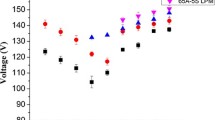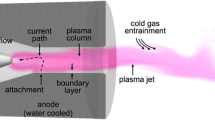Abstract
An extensive experimental investigation is carried out to construct a generalized model using theory of dynamic similarity for plasma spray torch behaviour in low-pressure environment. The generalized model is designed with a new set of dimensionless numbers to highlight the operational behaviour of the plasma torch at 10 mbar ambient pressure. These dimensionless numbers represent the effect of corresponding input parameters on the output behaviour of the plasma torch. A comparative analysis of these dimensionless numbers with their atmospheric counterparts highlights the effect of low pressure on the plasma torch operation. The current–voltage characteristics (CVC) and thermal efficiency of the plasma torch are experimentally measured at \(\sim \) 10 mbar chamber pressures at different arc current values, in the range of 100–500 A, for three different anode exit diameters, e.g. 8, 13 and 17 mm. Nitrogen is used as plasma-forming gas having flow rate range of 24–64 LPM. In addition to CVC profile and thermal efficiency, the plasma jet length at 10 mbar chamber pressure is also characterized using a very high-speed camera. A generalized model is also constructed to predict the plasma jet length in low pressure. The output of the model is verified by comparing with the experimental data at different input parameters and found to be in good agreement with the experimental data. This study presents a generalized relationship between input controllable parameters and output behaviour of a plasma spray torch, which is valid in the pressure range of \(\sim \) 10 to \(\sim \) 30 mbar.
Graphic abstract













Similar content being viewed by others
Data Availability Statement
This manuscript has no associated data or the data will not be deposited. The authors confirm that the data supporting the findings of this study are available within the article and its supplementary materials. If any more data are required during the review process, it will be made available upon request.
Abbreviations
- B :
-
Magnetic induction (T)
- d :
-
Anode exit diameter (m)
- G :
-
Gas flow rate (kg s\(^{-1}\))
- h :
-
Specific enthalpy (J kg\(^{-1}\))
- I :
-
Arc current (A)
- j :
-
Current density (A m\(^{-2}\))
- L :
-
Characteristic reference length (m)
- p :
-
Pressure (Pa)
- P :
-
Power (W)
- \(Q_r\) :
-
Volumetric radiation energy (W m\(^{-3}\))
- T :
-
Temperature (K)
- v :
-
Velocity (m s\(^{-1}\))
- V :
-
Arc voltage (V)
- \(\rho \) :
-
Density (kg m\(^{-3}\))
- \(\mu \) :
-
Viscosity (Pa s)
- \(\lambda \) :
-
Thermal conductivity (W m\(^{-1}\) K\(^{-1}\))
- \(\sigma \) :
-
Electrical conductivity (S m\(^{-1}\))
- \(\eta \) :
-
Thermal efficiency
References
M.F. Smith, A.C. Hall, J.D. Fleetwood, P. Meyer, Very low pressure plasma spray—a review of an emerging technology in the thermal spray community. Coatings 1(2), 117–132 (2011)
J.-L. Dorier, M. Gindrat, C. Hollenstein, M. Loch, A. Refke, A. Salito, G. Barbezat, Plasma jet properties in a new spraying process at low pressure for large area thin film deposition, in 2001, Proceedings of International Thermal Spray Conference (2001)
H. Ayrton, The Electric Arc (Cambridge University Press, Cambridge, 2012)
W.B. Nottingham, Normal arc characteristic curves: Dependence on absolute temperature of anode. Phys. Rev. 28, 764–768 (1926)
R.M. Gage, Arc torch and process—JTST historical patent #31. J. Therm. Spray Technol. 12(1), 29–33 (2003)
O. Chang, A. Kaminska, Influence of torch nozzle geometry on plasma jet properties. J. Phys. III 7, 1361–1375 (1997)
V. Goyal, R. Ganesh, P. Bandyopadhyay, S. Banerjee, Y. Vadikkeettil, S. Mukherjee, Study of dynamical behaviour of the plasma in a dc non-transferred plasma torch using fast imaging. Phys. Plasmas 24, 033506 (2017)
Y. Vadikkeettil, R. Ganesh, K. Ramachandran, V. Goyal, K. Meher, Influence of the shroud gas injection configuration on the characteristics of a dc non-transferred arc plasma torch. Plasma Chem. Plasma Process. 38, 07 (2018)
Y. Vadikkeettil, R. Ganesh, K. Ramachandran, Prediction of operational characteristics of a dc non-transferred arc plasma torch using similarity criteria. Eur. Phys. J. D 71, 10 (2017)
E. Buckingham, On physically similar systems; illustrations of the use of dimensional equations. Phys. Rev. 4, 345–376 (1914)
O. Yasko, Correlation of the characteristics of electric arcs moving in transverse magnetic fields. Proc. Inst. Electr. Eng. 116, 01 (1969)
J.-F. Brilhac, B. Pateyron, J. Coudert, P. Fauchais, A. Bouvier, Study of the dynamic and static behavior of de vortex plasma torches: part II: Well-tye cathode. Plasma Chem. Plasma Process. 15, 257–277 (1995)
V. Valincius, V. Krušinskaite, P. Valatkevičius, V. Valinčite, L. Marcinauskas, Electric and thermal characteristics of the linear, sectional dc plasma generator. Plasma Sour. Sci. Technol. 13, 199 (2004)
M. Hur, K.S. Kim, S. Hong, Operational features and air plasma characteristics of a thermal plasma torch with hollow electrodes. Plasma Sour. Sci. Technol. 12, 255 (2003)
A. Shashkov, O. Yas’ko, Application of approximate similarity for correlating arc characteristics. Plasma Sci., IEEE Trans. 1, 21–37 (1973)
A. Paingankar, A. Das, V. Shirodkar, K. Sreekumar, N. Venkatramani, Prediction of electrical characteristics of a non-transferred arc-plasma torch using principles of dynamic similarity. Plasma Sour. Sci. Technol. 8, 100 (1999)
G. Li, W. Pan, X. Meng, C. Wu, Application of similarity theory to the characterization of non-transferred laminar plasma jet generation. Plasma Sour. Sci. Technol. 14, 219 (2005)
R. Ramasamy, V. Selvarajan, Current-voltage characteristics of a non-transferred plasma spray torch. Eur. Phys. J. D 8, 125–129 (2000)
H. Kim, S. Hong, Comparative measurements on thermal plasma jet characteristics in atmospheric and low pressure plasma sprayings. Plasma Sci., IEEE Trans. 23, 852–859 (1995)
M. Gindrat, J.-L. Dorier, C. Hollenstein, M. Loch, A. Refke, A. Salito, G. Barbezat, Effect of Specific Operating Conditions on the Properties of LPPS Plasma Jets Expanding at Low Pressure. Proceedings of the ITSC2002. Thermal Spray 2002: Proceedings from the International Thermal Spray Conference. Essen, Germany, pp. 459–464. ASM. (2002). https://doi.org/10.31399/asm.cp.itsc2002p0459
M. Gindrat, J.-L. Dorier, C. Hollenstein, A. Refke, G. Barbezat, Characterization of supersonic low pressure plasma jets with electrostatic probes. Plasma Sour. Sci. Technol. 13, 08 (2004)
L. Robin, P. Vervisch, B. Cheron, Experimental study of a supersonic low-pressure nitrogen plasma jet. Phys. Plasmas 1, 444–458 (1994)
M. Hrabovsky, O. Chumak, V. Kopecký, M. Konrad, T. Kavka, Effect of pressure on behavior of anode attachment of dc arc plasma torch. High Temp. Mater. Process. 9, 391–399 (2005)
P. Domingo, A. Bourdon, P. Vervisch, Study of a low pressure nitrogen plasma jet. Phys. Plasmas 2, 2853–2862 (1995)
S. Selezneva, M. Rajabian, D. Gravelle, M. Boulos, Study of the structure and deviation from equilibrium in direct current supersonic plasma jets. J. Phys. D Appl. Phys. 34, 2862 (2001)
R.K. Mohanta, G. Ravi, Investigation of subsonic to supersonic transition of a low-pressure plasma torch jet. IEEE Trans. Plasma Sci. 50(9), 2941–2951 (2022)
O. Yas’ko, Some aspects of the generalization of electric arc characteristics. Pure Appl. Chem. 62, 1817–1824 (1990)
J.-F. Brilhac, B. Pateyron, G. Delluc, J. Coudert, P. Fauchais, Study of the dynamic and static behavior of dc vortex plasma torches: part i: button type cathode. Plasma Chem. Plasma Process. 15, 231–255 (1995)
A. D’angola, G. Colonna, C. Gorse, M. Capitelli, Thermodynamic and transport properties in equilibrium air plasmas in a wide pressure and temperature range. Eur. Phys. J. D 46, 129–150 (2008)
M. Planche, J. Coudert, P. Fauchais, Velocity measurements for arc jets produced by a dc plasma spray torch. Plasma Chem. Plasma Process. 18, 263–283 (1998)
E. Pfender, Chapter 5 - Electric Arcs and Arc Gas Heaters, Editor(s): Merle N. Hirsh, H.J. Oskam, Gaseous Electronics, Academic Press, pp 291–398 (1978) ISBN 9780123497017, https://doi.org/10.1016/B978-0-12-349701-7.50010-9
H.-P. Li, E. Pfender, X. Chen, Application of Steenbeck’s minimum principle for three-dimensional modelling of dc arc plasma torches. J. Phys. D Appl. Phys. 36, 1084–1096 (2003)
Y. Gao, D. Yang, J. Gao, Characteristics of a plasma torch designed for very low pressure plasma spraying. J. Therm. Spray Technol. 21, 06 (2012)
Acknowledgements
The author would like to thank Mr. Chirayu patil for his help in various troubleshooting during the experiments and Mr. O.R Kaila for fabricating the plasma torch components used in these experiments.
Author information
Authors and Affiliations
Contributions
Mr. Ram Krushna Mohanta is the primary and corresponding author of the manuscript and carried out all the experiments and analysis in the manuscript. Mr. Devilal Kumawat has contributed to the study in the high-speed imaging experiments and analysis. Dr. G. Ravi is the PhD supervisor of the corresponding author and has contributed in reviewing and validation of the results. Ms. Kumudni Tahiliani has also equally contributed in reviewing and validation of the obtained results.
Corresponding author
Rights and permissions
Springer Nature or its licensor (e.g. a society or other partner) holds exclusive rights to this article under a publishing agreement with the author(s) or other rightsholder(s); author self-archiving of the accepted manuscript version of this article is solely governed by the terms of such publishing agreement and applicable law.
About this article
Cite this article
Mohanta, R.K., Kumawat, D., Ravi, G. et al. Application of similarity theory to predict operational characteristics of a DC plasma torch under low-pressure condition. Eur. Phys. J. D 77, 89 (2023). https://doi.org/10.1140/epjd/s10053-023-00677-7
Received:
Accepted:
Published:
DOI: https://doi.org/10.1140/epjd/s10053-023-00677-7




